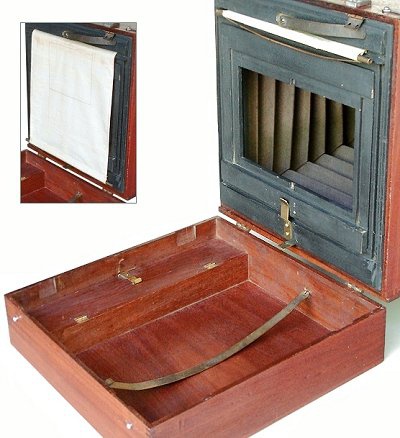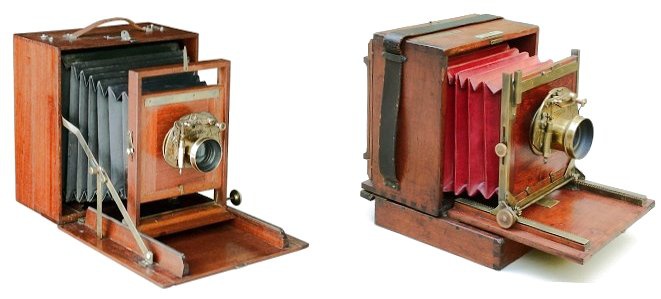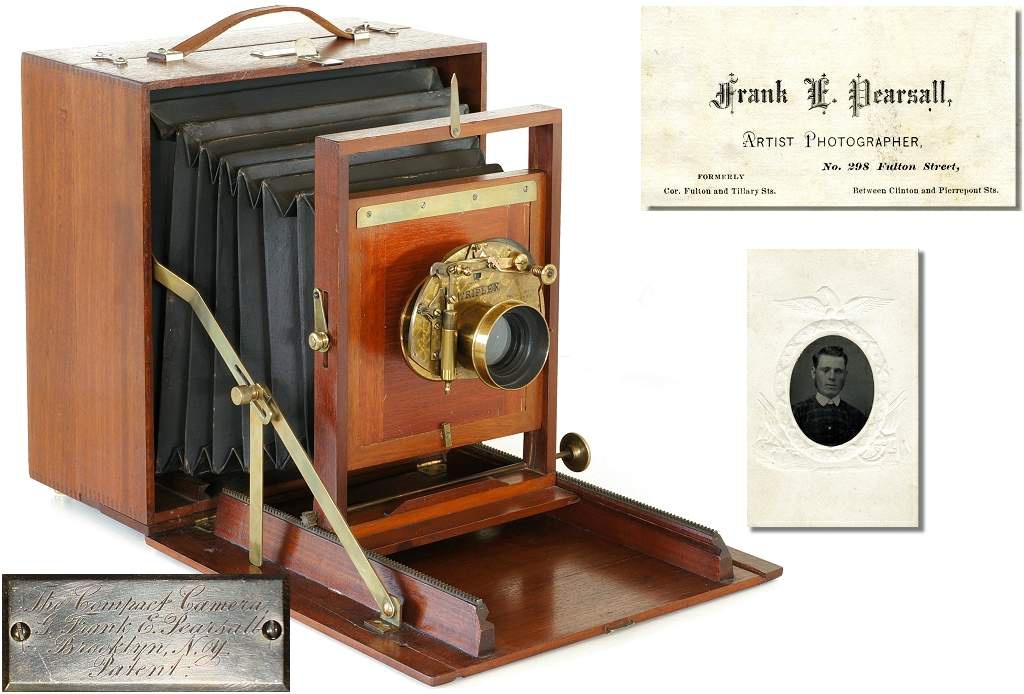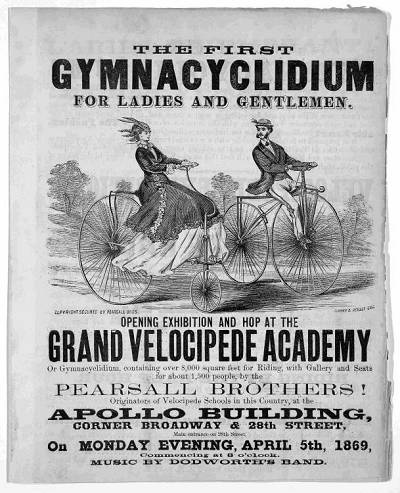|
|





Copyright ©2013 by Rob Niederman - ALL RIGHTS RESERVED
Refer to these Historic Camera links for additional information about Frank and Alva
Visit the Pearsall Timeline - Reference page
Visit the Pearsall Patents page
Return to the Self-Casing Cameras page
Visit the Pearsall Timeline - Reference page
Visit the Pearsall Patents page
Return to the Self-Casing Cameras page
Multi-Lens Cameras | View Cameras | Self-Casing Cameras | Solid Body Cameras | References & Advertisements
Home | What's New | Show Schedule | Wanted | For Sale | Links | Site Map | Email
Home | What's New | Show Schedule | Wanted | For Sale | Links | Site Map | Email
Pearsall before Cameras The scope of the Pearsall brothers (Frank
and Alva) interests is amazing and extensive information about their
participation in the Brooklyn society can be found in the Brooklyn Daily
Eagle archives and elsewhere on the Internet; therefore, this post will
limit its focus on background information on Frank's early gallery work
and leading up to the development of the first self-casing field camera.
Frank Pearsall, one of three sons, was born into a family steeped in photography. The well known daguerreotypist, Townsend Duryea, was the brother of Pearsall's mother. Duryea must have been a strong influence because the three Pearsall brothers, Alva, Frank and Charles eventually became career photographers. Alva and Frank, entrepreneurs in the late 1860s as operating the first Velocipede Academy (bicycle school), eventually became owners of competing Brooklyn galleries in the 1870s.
Frank Pearsall, one of three sons, was born into a family steeped in photography. The well known daguerreotypist, Townsend Duryea, was the brother of Pearsall's mother. Duryea must have been a strong influence because the three Pearsall brothers, Alva, Frank and Charles eventually became career photographers. Alva and Frank, entrepreneurs in the late 1860s as operating the first Velocipede Academy (bicycle school), eventually became owners of competing Brooklyn galleries in the 1870s.
Compact Camera, c.1883
G.F.E. Pearsall. Brooklyn, NY.
G.F.E. Pearsall. Brooklyn, NY.
Pearsall's Compact Camera: Forerunner to the Modern Folding Camera Technology vs. camera design; it is the photographic industry's
version of: 'What came first, the chicken or the egg?" Since introducing the first commercial photographic process in 1839, camera design and
photographic technology evolved together in a marriage so tightly intertwined, it is difficult to understand how (or why) one influenced the other.
Regardless, change was constant - daguerreotype to wetplate to dryplate to film and finally digital - huge transitions retooling an industry over its
180 year history that brought forth many exciting camera designs - both good and bad.
By the 1880s, photographic apparatus solidified into a few basic body patterns that lingered, practically unchanged, to the point that today it is sometimes difficult to distinguish one builder from another without the benefit of identifying labels. With few exceptions, major manufacturers appeared to be complacent and satisfied with small feature innovations to maintain or capture bigger chunks of market share. For example, American tailboard field cameras remained largely unchanged from the mid-1870s through the late 1890s. The front focusing equivalent of the tailboard was no different. European field camera designs also showed little variation over the years.
On April 3, 1883, the game changed. G. Frank E. Pearsall, a well known Brooklyn based gallery owner and photographer, was granted U.S. patent number 275073 for a portable "Folding Photographic Camera." It was unlike any existing design, a radical departure from traditional building and the first camera capable of folding into its own protective case (all delicate parts were completely encased within the outer body). Although the patent illustrates a camera closely resembling the few known examples in collections, there is no indication that Pearsall understood the historic significance of his design.
Unbeknownst to Pearsall at the time, the 'DNA' of his 1883 Compact Camera would eventually be rediscovered in 1890 by George Eastman, adopted by all major builders, and appear in every one of the smaller, refined self-casing cameras made through the mid 1900s!
By the 1880s, photographic apparatus solidified into a few basic body patterns that lingered, practically unchanged, to the point that today it is sometimes difficult to distinguish one builder from another without the benefit of identifying labels. With few exceptions, major manufacturers appeared to be complacent and satisfied with small feature innovations to maintain or capture bigger chunks of market share. For example, American tailboard field cameras remained largely unchanged from the mid-1870s through the late 1890s. The front focusing equivalent of the tailboard was no different. European field camera designs also showed little variation over the years.
On April 3, 1883, the game changed. G. Frank E. Pearsall, a well known Brooklyn based gallery owner and photographer, was granted U.S. patent number 275073 for a portable "Folding Photographic Camera." It was unlike any existing design, a radical departure from traditional building and the first camera capable of folding into its own protective case (all delicate parts were completely encased within the outer body). Although the patent illustrates a camera closely resembling the few known examples in collections, there is no indication that Pearsall understood the historic significance of his design.
Unbeknownst to Pearsall at the time, the 'DNA' of his 1883 Compact Camera would eventually be rediscovered in 1890 by George Eastman, adopted by all major builders, and appear in every one of the smaller, refined self-casing cameras made through the mid 1900s!
Brothers With Competing Galleries After working for others, Frank
and Alva became well known as Brooklyn based artists operating
competing galleries that opened in the early 1870s. Competition
between the brothers practically alienated them and they constantly
advertised in the Brooklyn Daily Eagle as owers of either the 'first' or
'original' galleries.
Competition between the brothers continued as they worked to differentiate their businesses by inventing various improvements in their pictures (i.e. Frank created an image style called the Knarfograph), but it was Frank who is mostly remembered as the portraitist of celebrities, politicians, and Brooklyn's socialites. Some of Frank's customers included:
• 1872: Walt Whitman
• 1872: Horace Greeley
• 1873: Gertrude Kellogg (actress)
• 1873: Roger A. Pryor (congressman, Confederate general, and jurist)
• Henry Ward Beecher & Wife (congregational preacher, orator)
• Reverend Dr. Thomas De Witt Talmage (1832 - 1902)
• 1874: Ellen Wrenshall Grant (the only daughter of Ulysses Grant)
• 1875: Francis D. Moulton (witness at Henry Ward Beecher's trial)
• 1875: Thomas G. Shearman (corporate lawyer / political economist)
• 1875: Samuel D. Morris (judge and also the district attorney)
• 1875: Joseph Neilson (presided over the "trial of the century")
• 1875: Reverend Theodore L. Cuyler, D.D. (1822-1909)
• 1880s - 1906: Henry Chadwick (the 'Father of Baseball')
Of note; in the early 1870s Frank developed a close relationship with Henry Chadwick, best known as the "father of the game." Over the years, Pearsall served as Chadwick's personal photographer and rendered portraits of the "father of the game" each year for his birthday, most of which graced the pages of the annual Spalding League Guide.
It is this unlikely connection with Chadwick and 1880s American baseball that might have been the inspiration for the Compact Camera.
The first reference to Frank's gallery was in the September 14, 1871 issue of the Brooklyn Daily Eagle in its Art Notes section. While no address is listed, the gallery was advertised at the corner of Tillary and Fulton Streets (1872).
In August of 1872, the 298 Fulton building was reconstructed and Frank was noted as having 'removed' from Tillary Street. His 298 Fulton Street gallery is believed to remain here until 1893; at which point there are references of Frank expanding to 1227 Bedford Avenue.
The last reference to Frank's gallery is 1906 in which the gallery occupied 1225 - 1227 Bedford Avenue. There are no further references to Frank owning a gallery after 1906.
* Frank's business card shown above likely dates to 1872 because it includes a comment that his address was formerly at the corner of Fulton and Tilleray Streets.
Competition between the brothers continued as they worked to differentiate their businesses by inventing various improvements in their pictures (i.e. Frank created an image style called the Knarfograph), but it was Frank who is mostly remembered as the portraitist of celebrities, politicians, and Brooklyn's socialites. Some of Frank's customers included:
• 1872: Walt Whitman
• 1872: Horace Greeley
• 1873: Gertrude Kellogg (actress)
• 1873: Roger A. Pryor (congressman, Confederate general, and jurist)
• Henry Ward Beecher & Wife (congregational preacher, orator)
• Reverend Dr. Thomas De Witt Talmage (1832 - 1902)
• 1874: Ellen Wrenshall Grant (the only daughter of Ulysses Grant)
• 1875: Francis D. Moulton (witness at Henry Ward Beecher's trial)
• 1875: Thomas G. Shearman (corporate lawyer / political economist)
• 1875: Samuel D. Morris (judge and also the district attorney)
• 1875: Joseph Neilson (presided over the "trial of the century")
• 1875: Reverend Theodore L. Cuyler, D.D. (1822-1909)
• 1880s - 1906: Henry Chadwick (the 'Father of Baseball')
Of note; in the early 1870s Frank developed a close relationship with Henry Chadwick, best known as the "father of the game." Over the years, Pearsall served as Chadwick's personal photographer and rendered portraits of the "father of the game" each year for his birthday, most of which graced the pages of the annual Spalding League Guide.
It is this unlikely connection with Chadwick and 1880s American baseball that might have been the inspiration for the Compact Camera.
The first reference to Frank's gallery was in the September 14, 1871 issue of the Brooklyn Daily Eagle in its Art Notes section. While no address is listed, the gallery was advertised at the corner of Tillary and Fulton Streets (1872).
In August of 1872, the 298 Fulton building was reconstructed and Frank was noted as having 'removed' from Tillary Street. His 298 Fulton Street gallery is believed to remain here until 1893; at which point there are references of Frank expanding to 1227 Bedford Avenue.
The last reference to Frank's gallery is 1906 in which the gallery occupied 1225 - 1227 Bedford Avenue. There are no further references to Frank owning a gallery after 1906.
* Frank's business card shown above likely dates to 1872 because it includes a comment that his address was formerly at the corner of Fulton and Tilleray Streets.
It seems that the Velcocipede Academy, while only open a couple
years, would be the last time the Pearsall brothers would be 'civil' with
each other.
Before opening competing galleries, Frank and Alva Pearsall were understudies for other photographers. Anthony's Bulletin Volume 23 (1892) noted: "Frank Pearsall, who later owned Howell's Brooklyn studio, was a "positionist" for photographer Jeremiah Gurney. Frank's brother Alva was a camera operator for Mathew Brady in 1871 and made ten negatives in 45 minutes of the visiting Grand Duke Alexis from Russia."
Before opening competing galleries, Frank and Alva Pearsall were understudies for other photographers. Anthony's Bulletin Volume 23 (1892) noted: "Frank Pearsall, who later owned Howell's Brooklyn studio, was a "positionist" for photographer Jeremiah Gurney. Frank's brother Alva was a camera operator for Mathew Brady in 1871 and made ten negatives in 45 minutes of the visiting Grand Duke Alexis from Russia."
Creation of the First Self-Casing Camera What was the motivation for a famous Brooklyn photographer to build a camera of original design? While
inconclusive, there are tantalizing references that Pearsall's connection to 1880s baseball might have been the reason. As a practicing studio artist,
the incentive to create an improved portable camera was almost certainly the result of an interest in shooting portraits of baseball and cricket
teams. According to baseball historian and author Peter J. Nash in his book Baseball Legends of Brooklyn's Green-Wood Cemetery, Pearsall was
deeply connected with America's national pastime:
"Frank Pearsall established himself as one of Brooklyn's premier artistic photographers of the later half of the 19th century. He was also an avid fan of the national game and became close friends with Henry Chadwick. Over the years, Pearsall served as Chadwick's personal photographer and rendered portraits for the "father of the game" each year for his birthday, most of which graced the pages of the annual Spalding League Guide."
More importantly, Nash also cites Chadwick commenting; "Pearsall invented a portable camera appropriate for baseball."
Given that Pearsall built and patented one camera, it is possible that Chadwick was referring to the Compact Camera. If true, Pearsall broke the manufacturing mold of traditional designs by creating apparatus specifically to support his own needs. As a point of reference, CGH Kinnear also changed the industry with the invention of tapered bellows used in his 1859 field camera.
Note: I have been in contact with the Baseball Hall of Fame library in an attempt to uncover the exact Chadwick primary reference mentioned by Nash; however, Pearsall's portraits of Chadwick are well known and appear in annual issues of Spalding's Official Baseball Guide.
Similar to the Tucker automobile, Pearsall's 1883 Compact Camera was ahead its time but not accepted as a "game changer." As the self-casing camera concept languished throughout the intervening years, a second attempt was tried in 1888 with little fanfare by an unknown American builder: William C. Gibbs of Oakland, California. It too failed to capture the hearts of photographers and only a couple surviving examples are known.
"Frank Pearsall established himself as one of Brooklyn's premier artistic photographers of the later half of the 19th century. He was also an avid fan of the national game and became close friends with Henry Chadwick. Over the years, Pearsall served as Chadwick's personal photographer and rendered portraits for the "father of the game" each year for his birthday, most of which graced the pages of the annual Spalding League Guide."
More importantly, Nash also cites Chadwick commenting; "Pearsall invented a portable camera appropriate for baseball."
Given that Pearsall built and patented one camera, it is possible that Chadwick was referring to the Compact Camera. If true, Pearsall broke the manufacturing mold of traditional designs by creating apparatus specifically to support his own needs. As a point of reference, CGH Kinnear also changed the industry with the invention of tapered bellows used in his 1859 field camera.
Note: I have been in contact with the Baseball Hall of Fame library in an attempt to uncover the exact Chadwick primary reference mentioned by Nash; however, Pearsall's portraits of Chadwick are well known and appear in annual issues of Spalding's Official Baseball Guide.
Similar to the Tucker automobile, Pearsall's 1883 Compact Camera was ahead its time but not accepted as a "game changer." As the self-casing camera concept languished throughout the intervening years, a second attempt was tried in 1888 with little fanfare by an unknown American builder: William C. Gibbs of Oakland, California. It too failed to capture the hearts of photographers and only a couple surviving examples are known.
Comparison of the 1883 Pearsall Compact and 1888 Gibbs cameras. (The first two self-casing field cameras.)
The upright post on the front standard is a 'gunshot sight' meant to serve as a speed finder according to Pearsall's patent and advertising.
The upright post on the front standard is a 'gunshot sight' meant to serve as a speed finder according to Pearsall's patent and advertising.
Above: Side view showing the unusual design in which the back folds downward.
Right: Rear view showing the retractable silk viewing screen that replaces a fragile ground glass. This feature was never used in any other camera. The patent also described a rear viewing bellows that removed the need for a dark cloth. Unfortunately the rear bellows was lost over the years. The back is also deep enough to hold the viewing bellows and store plateholders. Of special note, this specific camera is the largest known (whole-plate) with notches for stereo photography. The back of an uncut lensboard (also with the camera) has pencil markings for a septum.
Right: Rear view showing the retractable silk viewing screen that replaces a fragile ground glass. This feature was never used in any other camera. The patent also described a rear viewing bellows that removed the need for a dark cloth. Unfortunately the rear bellows was lost over the years. The back is also deep enough to hold the viewing bellows and store plateholders. Of special note, this specific camera is the largest known (whole-plate) with notches for stereo photography. The back of an uncut lensboard (also with the camera) has pencil markings for a septum.

